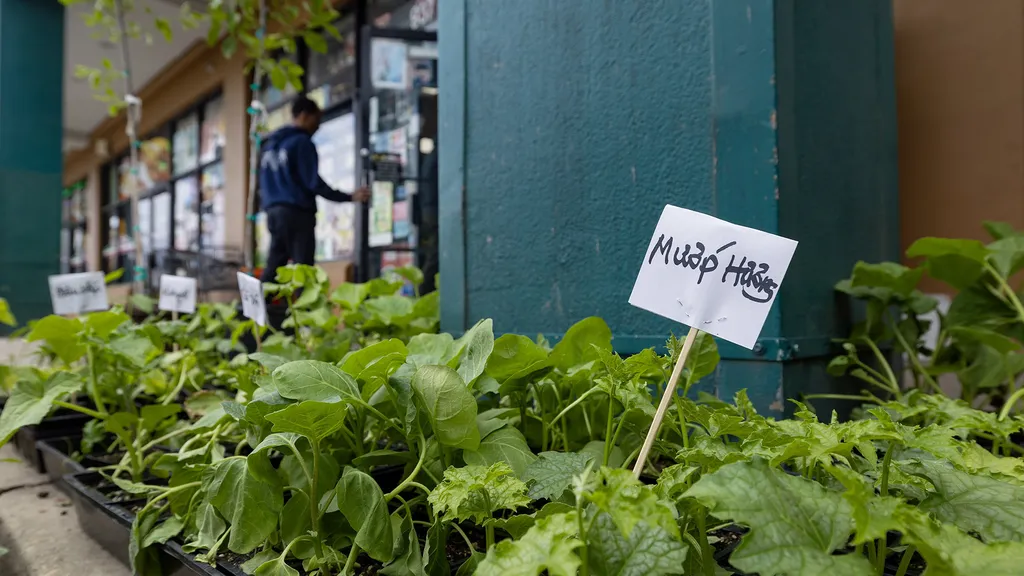- April 16, 2025
- By Sala Levin ’10
Hannah Tran ’28 was raised on aromatic noodle soups topped with handfuls of mint or basil, and grilled meat with rice prepared by her Vietnamese-born mom. In their Silver Spring, Md., yard, Tran’s parents grow a fibrous squash called luffa and mild, grassy-tasting chrysanthemum leaves, known as tan ô, that turn tender in a hot pot or are eaten raw in salads.
Even though she’s never been to Vietnam, Tran said, “I feel a strong connection to being Vietnamese through what my mother feeds me.”
Now, Tran is in a new University of Maryland class that lets students digest the importance of culinary traditions to the state’s immigrant communities. In the Department of American Studies course “Maryland’s Ethnic Foodways,” undergraduates learn ethnographic research skills by talking to members of immigrant populations in Montgomery and Prince George’s counties about the dishes they cook, the ingredients they use and the stores that sell familiar products.

“At a baseline level, everybody loves to eat,” said Madeline Hsu, professor of history and director of UMD’s Center for Global Migration Studies, who co-teaches the course with Psyche Williams-Forson, professor and chair of the American studies department. “A lot of times, foodways and the deep significance of food in people’s everyday lives are attached to family and community histories.”
Hsu and Williams-Forson highlight the ways in which the creation and commerce of food products are connected to gender, class, race and other sociocultural factors.
At the beginning of a recent class, Hsu laid out a sampling of snacks she’d bought at a local H Mart, a national chain of Asian supermarkets. She encouraged students to try savory prawn crackers; a chewy, milky-flavored caramel candy from China called White Rabbit; and haw flakes, thin pink discs made from hawthorn fruit.
The main project of the semester asks students to team up to visit one of four international food markets in the area: Guru Groceries and Chaat House in Bethesda sells Indian products, Angkor Supermarket in Takoma Park supplies Southeast Asian ingredients, Eko International Store in Hyattsville offers African foods, and Manila Mart in Beltsville specializes in Filipino groceries.
Students' final projects will tell the stories of the store owners and their ethnic grocery businesses in digital formats that will appear in a publicly available digital archive being developed by the Center for Global Migration Studies to complement the existing Archive of Immigrant Voices. (Hsu and Williams-Forson have received a Teaching Innovation Grant from the Teaching and Learning Transformation Center, a Harmony Grant from the College of Arts and Humanities and funding for an intern from the Undergraduate Technology Apprenticeship Program.)
“This is an intensive campus-to-community learning experience,” said Hsu. “They’re learning how to pay attention to stories, what we can see in terms of migration, how people have adapted and made their lives here. They’re figuring out how to tell those stories.”
During the class session, students took turns role-playing an interview, coming up with questions they might ask the stores’ proprietors: How did you get into the food business? Why did you choose this neighborhood? Where do you source your products?
Businesses like the ones the students are examining can “become major epicenters for community bonding and providing familiar foodstuffs to immigrants who are looking for connections to home,” said Williams-Forson.
That’s something Tran has experienced. She was struck at Angkor Supermarket by how similar it seemed to the Vietnamese store in Wheaton where she and her family shop. She was surprised to learn that its owner is Eritrean, and that he previously managed a 7-Eleven with lots of Asian customers, bringing him into contact with the supermarket’s previous owners when they were looking to sell.
The course has changed how Tran sees her own mother’s cooking, she said. One theme of the class has been how immigrants use food to both assimilate into American culture and hold onto their heritage. “I was thinking a lot about how my mom cooks Vietnamese food with ingredients sourced from America,” Tran said. “She claims we’re her American children and we should eat American food, or that we like to eat American food.”
Tran hopes that one day her mom will teach her the intricacies of Vietnamese cooking, but for now that’s one area where her mother dominates. “I’m not allowed in the kitchen at home when she’s there,” Tran said.
All through April, Maryland Today will celebrate how the University of Maryland is reimagining learning and teaching. Find more stories at today.umd.edu/topic/we-reimagine-learning.
